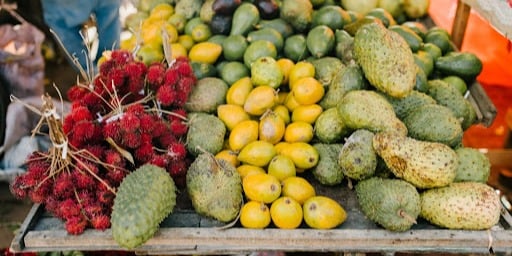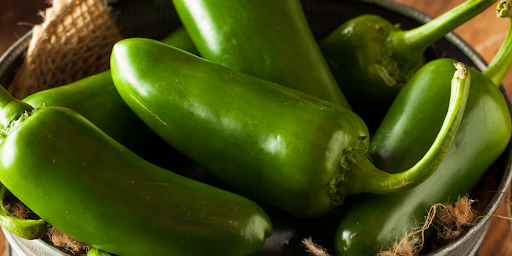What on Earth is That? Costa Rican Fruits- Part 2

In the last post we talked about how many wild and wonderful new fruits you can find at the local markets, known as ferias, here in Costa Rica. In fact, when I started looking into it, there were too many for just one post.
So, here we are again!
More Costa Rican Fruits!
Lima or Limes

Season: Year-round
Description: Small round fruit with a thin green peel and yellow-green flesh
Flavour: Very tart, and similar to a lemon
Use: Juice, marinade, and...
Lemons, for whatever reason, are quite hard to find here, limes take their place for use in limeade, a tart but refreshing drink. And more often than not, these limes are different from what you’re used to, with orange flesh and a sweeter (but still tangy) flavor.
The most common use for lime juice here, is to be made into the marinade in ceviche, an extremely popular dish. The acid in the juice ‘cooks’ the raw fish without heat. Click the link to find a recipe for this typical Costa Rican delicacy.
Maracuya or Passionfruit

Season: Found all year but best between May-March and August-December
Description: Yellow to yellow-green round fruit filled with a whitish-yellow goo and lots of seeds
Flavour: Similar to guaba, which is technically a legume, if you aren’t familiar with that it's a sweet musty citrus flavour
Use: Eaten fresh, used in juices and smoothies, made into jams, preserves or dessert toppings, in Cambodia it is used to make wine or liquor
Thanks to my research, I now know you are supposed to scoop out the delicious inside of the passionfruit, and then spit out the seeds. However, the seeds are often left in when used for things like cheesecake or cocktails!
From the same family as the maracuya, you have the granadilla. It has different types of seeds and a very different flavor. Very simple to open up and very easy to eat (all you need is a small spoon).

Naranja or Oranges

Season: July-August
Description: Unlike what I was used to back in North America, oranges here are harvested when they are green, perhaps because the majority of them are exported and will ripen during transit.
Flavour: These green oranges aren’t as juicy or as sweet as what I was used to back home, but the flavour remains essentially the same
Use: 40% of all oranges worldwide are used to make juice! They are also eaten fresh, added to salads and made into jams and marmalades.
Fun Fact! Costa Rica has almost 5 Million orange trees, and yet they are still picked by hand! You can take tours of the orange groves, the majority of which are located in the Central Valley, not far from the coffee plantations that I told you about in a previous post.
Manzana de Agua or Water Apple

Season: March-May
Description: They look very similar to apples except for their elongated, almost pear-like shape. They have one large pit in the center
Flavour: Water apples taste exactly how they sound, similar to the apples you’re used to in North American but with a slightly gentler flavour
Use: As a fresh fruit snack!
Fun Fact: Everything on the water apple tree is useful. The wood is hard and used to make tools, the bark is collected and used in herbal medicine (as an astringent for thrush), and the leaves are edible and used in many cultures to wrap food. Great all around!
Zapote/Mamey-Sapota

Season: May-July
Description: Technically a berry, the zapote is oblong with a rough brown skin and flesh that ranges in colour from pink/orange/red
Flavour: The flesh is creamy and tastes like a blend of cantaloupe, peach and sweet potato, if you can imagine that
Use: Used to make milkshakes and ice cream, eaten raw, made into marmalade or jam.
Fun Fact: You can actually slice zapote and fry it like bacon… definitely adding that to my list! The oil from this fruit is also used in some beauty products.
Pejibaye or Peach Palm Fruit

Season: Year-round
Description: Small and round with a skin that ranges from yellow to red, when raw, usually found in a cluster still attached to the branch
Flavour: Pejibaye is typically stewed for thirty minutes in salt water before it is eaten. In this case, the peeled fruit has a texture like firm sweet potato and the taste is a cross between cooked squash and roasted chestnuts
Use: Eaten cooked, sometimes with mayonnaise, made into a creamy soup, preserved or dried into meal and used in place of corn.
I see pejibayes all the time at the local market! They are usually floating in water and I first assumed they were little stewed tomatoes, but they’re actually far more interesting!
The peach palm is an important plant in Latin and Central America, and another one with quite the variety of uses!. The fruit is tasty, the oil from the palm is a valuable export, the timber is used for making tools, and the roots are used as medicine. Even the spines are used as needles and the leaves are used to create thatch and weave baskets.
Nothing on the peach palm gets wasted!
Jocote or Red Mombin
Season: August-December
Description: Small round fruits about the size of a large cherry tomato. They can range in colour from green to red-yellow or yellow depending on the variety and usually have a strange protuberance on one end, like a little knob. The ripe flesh is yellow in colour and contains a large pit.
Flavour: Sweet and juicy, similar to a plum
Use: Eaten raw (usually with salt), mashed and made into a beverage with water and sweetener, or boiled in water to make a honey-like syrup or preserves.
The unripened jocote fruit can also be eaten but they’re much more bitter. More often they are made into a sauce or pickled with vinegar/ lime, then eaten with chili peppers and salt.
Guaba/Pacay or Ice Cream Beans

Season: January-June
Description: Long pods full of creamy beans
Flavour: Sweet and creamy — there’s a reason these beans have earned the nickname “ice cream beans”! (sign me up!)
Use: Eaten raw as a snack, boiled and eaten as a vegetable, or roasted and eaten as a nut.
In Costa Rica, the guaba plant is associated with luck, perhaps the trees are dependable, and provide abundant food at times when other crops may not. They are resistant to fire and disease and grow on or near riverbanks where they always have enough water. Plus, they’re tasty!
Anona or Bullocks Heart or Sugar Apple

Season: Year-round in hot regions, in the fall in more temperate regions
Description: Lumpy (kind of like a pinecone) heart-shaped fruit ranging from green to reddish brown with a white pulp and black seeds
Flavour: Very sweet and creamy with a nice fragrance
Use: Typically eaten fresh by scooping the creamy middle out with a spoon, or used for smoothies and ice cream.
I found this juicy tidbit on Wikipedia… although I have no idea how to pronounce that word!
Fun Fact:
Paleoethnobotanical studies have dated Annona exploitation and cultivation in the Yautepec River region of Medicoto to approximately 1000 BC. (Warrington, Ian J. Warrington (2003). "Annonaceae". Apples: Botany, Production and Uses. CABI Publishing. ISBN 0-85199-592-6. Retrieved 2008-04-20.)
And So Many More To Discover!
Two posts in and I haven’t even scratched the surface when it comes to all the tropical fruits available here!
Every time I think I’m getting close, I find another list of tropical fruits. But, I’m going to stop here anyhow. The best way to learn this, it seems, is to come on down and stroll the feria yourself.
Then you can touch, smell, and taste all of these fruits in person, and get to know the wonderful people that farm them! That’s certainly my plan, especially now that I have a better idea what to look for and which ones I think I will like.
Note: Before publication, I wanted to add that I’ve seen ice cream beans! I had no idea they would be so yummy. Definitely grab them next time you see them!
Until then, Pura Vida!






